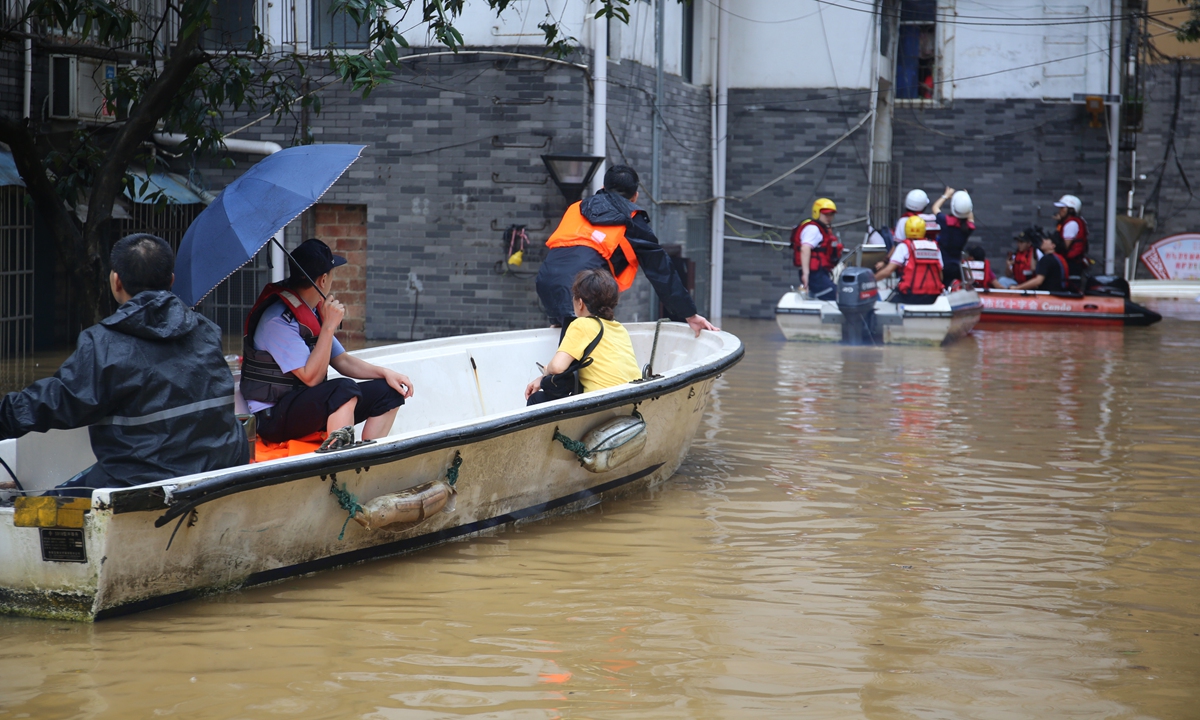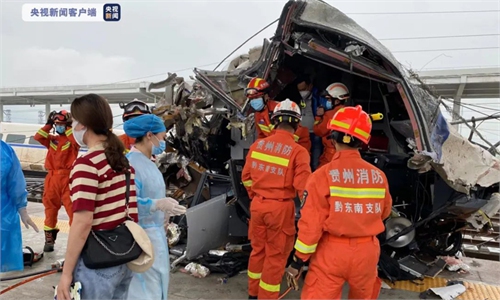Train derailment sounds alarm for road, rail networks as flood season in S.China comes

Bouquets are placed under a street lamp in front of Rongjiang station square in Qiandongnan Miao and Dong Autonomous Prefecture, Southwest China's Guizhou Province, on June 5, 2022, in memory of Yang Yong, the hero driver, who died during the train derailment. Photo: VCG
The Guizhou-Guangzhou Railway resumed operation on Sunday after a high-speed train derailed in Southwest China's Guizhou Province due to a mudslide on Saturday, killing a driver and injuring one attendant and seven passengers.
The accident sounded an alarm for the dense railway and highway networks on how to reduce safety risks during frequent abnormal weather conditions, given the flood season in southern China is approaching.
Two coaches of the D2809, a bullet train from Guiyang, Southwest China's Guizhou Province, to Guangzhou, South China's Guangdong Province, derailed at a tunnel entrance of the Rongjiang station in Guizhou due to a mudslide that intruded on the rail track at 10:30 am on Saturday, leading to the death of the driver.
One attendant and seven passengers sustained non-life threatening injuries and have received proper treatment, said a post on the official Weibo account of Southwest Railway, owned by the Chengdu Bureau of China Railway.
All the injured people were sent to a local hospital and the other 136 passengers were transferred and excavated.
The driver, who died during the accident, spotted a track abnormality as the bullet train passed through the Yuezhai tunnel, and quickly instituted emergency braking measures within five seconds that only made the train slide over 900 meters, China Railway said on Saturday, after analyzing on-board data.
China Railway Chengdu Group Co said on Sunday that after nearly 21 hours of rescue work, service at the Rongjiang station, which was suspended due to the derailment, had been restored, and the Guizhou-Guangzhou Railway had resumed operation.
The railway authorities vowed to find the cause of the accident as soon as possible, and to push forward a campaign to ensure the safety and smooth operation of the railway.
Meanwhile, at about 10 am on Sunday, amid continuous heavy rainfall in some parts of Guizhou Province, a geological disaster of sinkhole occurred near another local line. Railway departments immediately launched emergency response plans, blockaded the section, and organized personnel to repair the line, according to China Railway Chengdu Group Co.
Early warnings and overall judgment of abnormal weather changes are vital, Wang Yuanfeng, a professor at the School of Civil Engineering at Beijing Jiaotong University, told the Global Times on Sunday.
The expert called for strengthening inspections and examinations in the railway engineering system, such as installing fixed monitoring devices at high-risk areas, using drones to patrol certain segments and utilizing satellite images for judging the situations in wider ranges.
"Besides the use of advanced technologies, traditional human inspection should be enhanced during extreme weather, and related inspection mechanisms should be built and improved for both the railway and highway networks," Wang noted.
The national flood control and drought relief authority raised its emergency response to floods to Level III on Saturday, following floods and geological disasters of varying degrees in eight southern Chinese provinces and regions due to recent heavy rains.
As a result of multiple rounds of rainfall, the soil is saturated, and water at the bottom of rivers is high, which makes mountain torrents, geological disasters and small and medium-sized river floods very easy to occur. The authority requested related departments in Hunan, Guizhou, Guangxi, Jiangxi, Fujian, Guangdong, Zhejiang and Anhui provinces and autonomous regions to prevent and prepare for floods and deal with emergencies.

Police officers ride boats to rescue people trapped in a flooded residential area in Liuzhou, South China's Guangxi Zhuang Autonomous Region, on June 5, 2022. Affected by continuous heavy rainfall upstream since June 3, the Liujiang River experienced the biggest flood so far this year. Photo: VCG
According to the National Meteorological Center (NMC), heavy rain is expected to continue on Sunday and Monday in southern China. Cumulative rainfall in some areas of Hunan, Jiangxi, Zhejiang, Fujian, Guangxi, Guangdong and six other provinces and autonomous regions can reach 100 to 200 millimeters (mm), while some can reach more than 300 mm.
The NMC said some of these areas will also experience short-term heavy rainfall or strong convective weather such as thunderstorms, with rainfall of 30 to 60 mm per hour, locally exceeding 80 mm
Provinces and autonomous regions including Zhejiang, Jiangxi, Hunan, Fujian, Guangxi and Guangdong are urged to strengthen the prevention of secondary disasters.
On Saturday, China's Ministry of Emergency Management vowed to strengthen monitoring and early warning systems, closely follow weather changes, launch emergency responses in a timely manner, and take preventive measures. Priority should be given to preventing geological disasters caused by mountain floods, and evacuating people in dangerous areas, said the authority.
Also, it requested an enhancement of patrol and defense operations over potential river floods, and ensuring the safety of flood control work.


